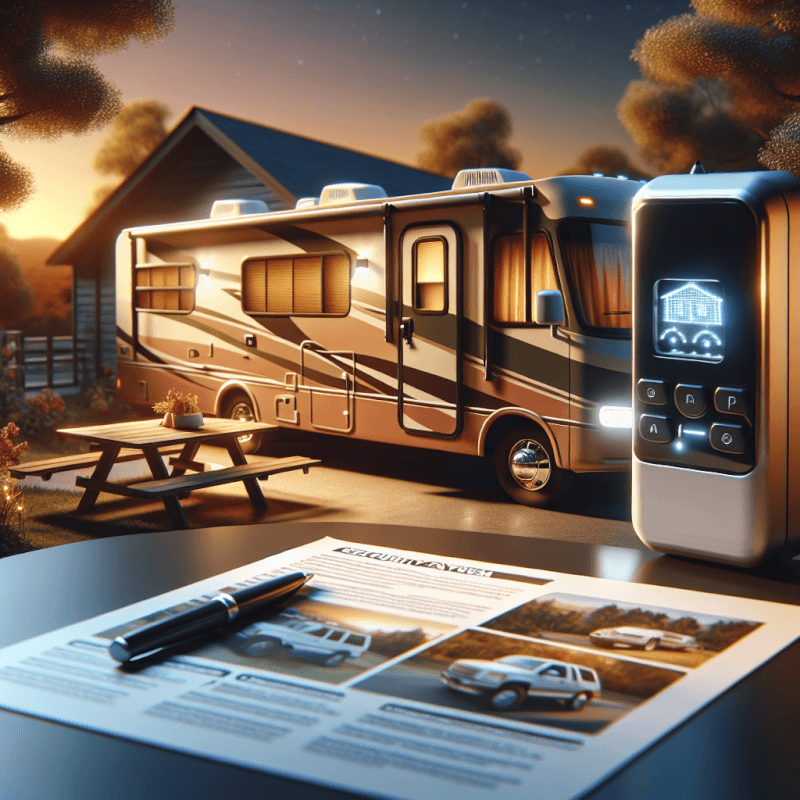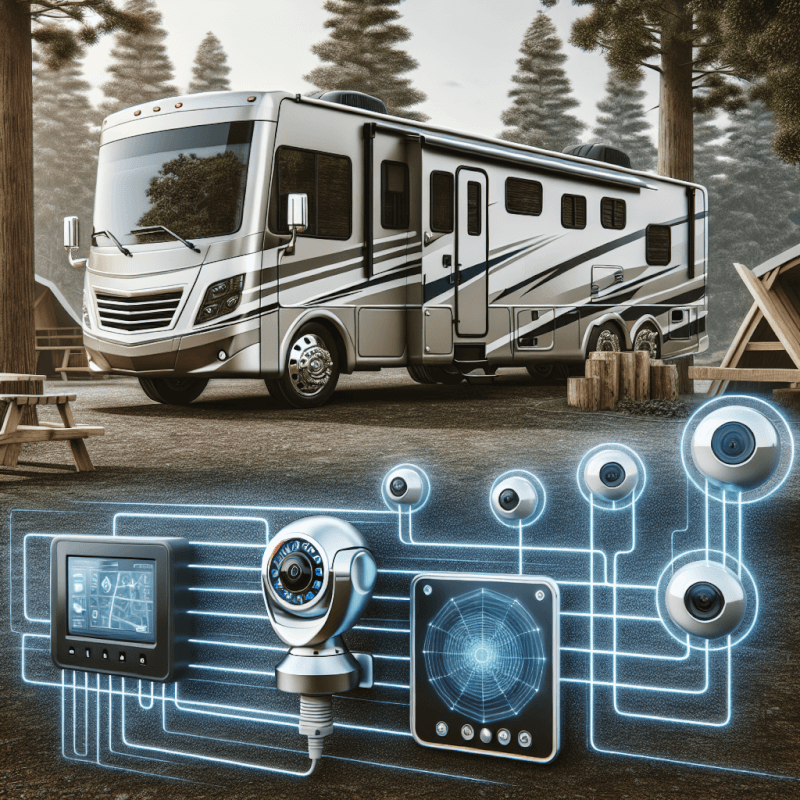If you’re an RV owner, you probably cherish the freedom and flexibility that comes with life on the road. But what about the security of your beloved home on wheels? That’s where the question arises: can you install a security system in your RV? Whether you’re concerned about theft or simply want peace of mind, this article will explore the options available to protect your mobile haven. From basic alarms to high-tech cameras, join us as we delve into the world of RV security systems and find out how you can safeguard your home away from home.
Can I Install A Security System In My RV?

Types of RV Security Systems
When it comes to installing a security system in your RV, there are several options available to choose from. The two main types of security systems for RVs are wired and wireless. Each type has its own set of advantages and considerations, so it’s important to understand the differences before making a decision.
Wired Security Systems
Wired security systems are installed by running wires throughout your RV to connect various components of the system. This type of system typically requires professional installation and can be more complex and time-consuming to set up. However, wired security systems are known for their reliability and stability, as they are not affected by interference or signal disruptions.
Wireless Security Systems
On the other hand, wireless security systems are becoming increasingly popular among RV owners due to their ease of installation and flexibility. These systems use wireless technology to connect the various components, such as sensors and cameras, without the need for extensive wiring. Wireless security systems are generally DIY-friendly and can be easily installed and set up by RV owners themselves.
DIY Security Systems
For RV owners who enjoy taking on DIY projects, a DIY security system may be the ideal choice. These systems typically come in kits that include all the necessary components and step-by-step instructions for installation. DIY security systems offer the advantage of cost savings, as there are no professional installation fees involved. However, it is essential to carefully follow the instructions provided to ensure proper installation and functionality.
Professional Security Systems
If you prefer a hassle-free installation process or are not confident in your DIY skills, hiring a professional to install a security system in your RV is an option worth considering. Professional security systems offer the benefit of expertise and experience in installing complex systems. They can assess your RV’s specific security needs and recommend the right components and configuration for optimal security.
Choosing the Right Security System for Your RV
Selecting the right security system for your RV involves considering several factors that are unique to your situation and preferences. By taking into account these factors, you can ensure that the security system you choose provides the level of protection and peace of mind you desire.
RV Size and Layout
The size and layout of your RV play a crucial role in determining the type and number of security components you need. Larger RVs may require more sensors, cameras, and detectors to adequately cover all the areas of your vehicle. Consider the number of entry points and vulnerable areas that need surveillance or protection when choosing a security system.
Budget and Cost
Your budget will naturally be a significant consideration when selecting an RV security system. Determine how much you are willing to invest in a security system and consider both the upfront costs and potential ongoing expenses. Keep in mind that while DIY systems may be more affordable initially, they may require additional maintenance or component replacement over time.

Ease of Installation
Consider your own skill level and comfort with DIY installations when choosing a security system. If you are confident in your abilities and enjoy taking on projects, a DIY system may be a suitable choice. However, if you prefer a professional installation or lack the necessary skills, opting for a system that includes professional installation services may be the best decision to avoid any potential complications or errors during setup.
Connectivity Options
Another factor to consider is the connectivity options offered by the security system. Most systems offer options for remote monitoring and control, either through a mobile app or a web interface. Ensure that the system you choose is compatible with your preferred method of connectivity and offers the features that align with your needs.
Features and Technology
Take a closer look at the features and technology offered by different security systems. Some may include motion sensors, infrared night vision cameras, or even integration with smart home automation systems. Consider what features are most important to you and choose a system that aligns with your specific requirements.
Installation Process for RV Security Systems
Once you have selected the right security system for your RV, it’s time to move on to the installation process. While the specific steps may vary depending on the chosen system, there are a few general considerations and procedures to keep in mind to ensure a successful installation.

Planning and Preparation
Before diving into the installation, take the time to carefully plan out the placement and positioning of the various components. Consider factors such as optimal coverage, accessibility, and aesthetics. Create a detailed installation plan or diagram to guide you through the process.
Selecting the Mounting Locations
Identify the best mounting locations for sensors, detectors, cameras, and other components based on your RV’s layout and the coverage requirements. Ensure that the chosen locations are secure and allow for easy access when maintenance or adjustments are needed.
Installation of Sensors and Detectors
Follow the manufacturer’s instructions to properly install sensors and detectors in the designated locations. These devices are essential for detecting any unauthorized entry, movement, or other potential security breaches. Securely mount them, ensuring they are aligned correctly for optimal functionality.
Power Source and Wiring
Consider how the security system will be powered and ensure that you have access to a suitable power source. Depending on the system, this may involve connecting to the RV’s electrical system or utilizing batteries and solar power. If wired components are necessary, carefully route and conceal the wires to maintain a neat and organized appearance.

Connecting to a Control Panel
Most security systems include a control panel or hub that serves as the central command center for the system. Follow the provided instructions to connect the various components to the control panel, ensuring proper communication and functionality. Test the connections and ensure that all components are successfully integrated.
Testing and Troubleshooting
Once the installation is complete, thoroughly test the entire system to ensure all components are working correctly. Walk through each sensor’s detection range, check camera feeds, and verify that remote monitoring and control functions are operational. In case of any issues, consult the troubleshooting section of the user manual or contact the manufacturer’s support for assistance.
Maintenance and Upkeep of RV Security Systems
To maximize the effectiveness and longevity of your RV security system, regular maintenance and upkeep are necessary. By following these guidelines, you can ensure that your system remains in optimal condition, providing reliable security for your RV.
Regular Inspections and Checks
Periodically inspect all components of your security system, including sensors, detectors, cameras, and the control panel. Look for any signs of wear and tear, loose connections, or malfunctions. Regular inspections can help you detect and address potential issues early on, ensuring your system functions properly.

Battery Maintenance
If your security system relies on batteries for power, it is crucial to routinely check and maintain them. Follow the manufacturer’s recommendations for battery maintenance, including charging, replacing, or recharging as necessary. Keep spare batteries on hand in case of emergencies.
Software and Firmware Updates
Stay up to date with the latest software and firmware updates provided by the manufacturer. These updates often improve the system’s performance, add new features, or address any security vulnerabilities. Regularly check for updates and follow the instructions to install them correctly.
Cleaning and Dusting
To maintain the quality and clarity of camera feeds and the functionality of other components, clean and dust them regularly. Use a soft, lint-free cloth or a recommended cleaning solution to wipe away any dirt, dust, or smudges. Avoid using abrasive materials that may scratch or damage the equipment.
Troubleshooting Common Issues
Even with regular maintenance, it’s possible to encounter occasional issues with your RV security system. Become familiar with common troubleshooting techniques, such as resetting the system, checking for loose connections, or adjusting sensor sensitivity. Refer to the user manual or contact the manufacturer’s support for specific guidance.
Tips for Maximizing the Effectiveness of RV Security Systems
While installing a security system in your RV is a significant step towards enhanced safety, there are additional measures you can take to maximize its effectiveness. Consider implementing the following tips to further secure your RV and protect your belongings.
Positioning Security Cameras
Strategically position security cameras to cover all entry points, vulnerable areas, and high-value items inside your RV. Ensure that the cameras have a clear line of sight and cover the desired areas effectively. Additionally, consider installing visible cameras as a deterrent to potential intruders.
Securing Entry Points
In addition to a security system, reinforce the security of your RV’s entry points, such as doors and windows. Install sturdy locks and latches that are difficult to tamper with or forcibly open. Consider adding additional security measures, such as door and window alarms or reinforcing panels.
Utilizing Access Control Measures
Implement access control measures, such as keyless entry systems or biometric locks, to limit unauthorized access to your RV. These advanced security features provide an extra layer of protection and reduce the risks associated with lost or stolen keys.
Investing in GPS Tracking
For added peace of mind, consider investing in a GPS tracking device for your RV. These devices allow you to track the location of your RV in real-time, making it easier to recover in case of theft. GPS tracking systems often include additional features such as geofencing and remote immobilization.
Using Alarm and Notification Systems
Integrate your RV security system with alarm and notification systems to ensure that you are promptly alerted to any security breaches. These systems can send alerts, notifications, or even trigger sirens or lights when a sensor is triggered. Stay connected and informed, even when you are away from your RV.
Conclusion
Protecting your RV and its contents is of utmost importance, and installing a security system can greatly enhance your peace of mind. Whether you opt for a wired or wireless system, DIY or professional installation, it’s crucial to consider factors such as your RV’s size and layout, budget, ease of installation, connectivity options, and desired features. Proper planning, installation, and maintenance will ensure that your RV security system functions effectively and provides the added security you need during your travels.


